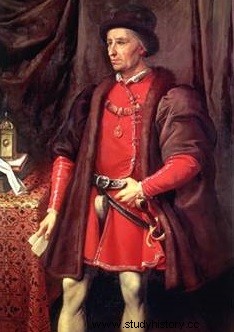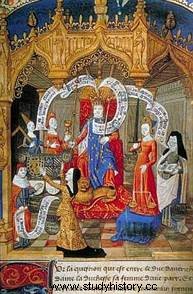 King of France from 1461 to 1483, Louis XI , nicknamed “the universal aragne”, had the heavy task of restoring to France its lost prosperity during the Hundred Years War. Turbulent son of Charles VII, he has a reputation as a harsh ruler, sometimes seen as a tyrant. His reign was nevertheless fundamental, both in the life-and-death struggle he waged against the Duke of Burgundy Charles the Bold, and in the affirmation of a monarchy increasingly centralized in the person of the king. As France once again experienced an economic boom, the reign of Louis XI , however authoritarian, will allow the advent of the kings of the Renaissance and with it the influence of France, which becomes the first European power.
King of France from 1461 to 1483, Louis XI , nicknamed “the universal aragne”, had the heavy task of restoring to France its lost prosperity during the Hundred Years War. Turbulent son of Charles VII, he has a reputation as a harsh ruler, sometimes seen as a tyrant. His reign was nevertheless fundamental, both in the life-and-death struggle he waged against the Duke of Burgundy Charles the Bold, and in the affirmation of a monarchy increasingly centralized in the person of the king. As France once again experienced an economic boom, the reign of Louis XI , however authoritarian, will allow the advent of the kings of the Renaissance and with it the influence of France, which becomes the first European power.
Louis XI, turbulent son of Charles VII
Born in 1423, when France was in a very bad position against the English (the Treaty of Troyes was signed in 1420), Louis was the son of Charles VII (who is not yet king) and Marie d'Anjou. He benefits from a high quality education, particularly in law and theology, but, having become the Dauphin, he is also a political instrument of his father. The latter married him in 1436 to Margaret of Scotland, to whom he apparently left a very bad memory (she died at only 21 years old).
 While Charles VII entrusted him with increasingly important responsibilities, Louis emancipated himself a little more in n not hesitating, in the company of John II of Alençon, to join the so-called revolt of Praguerie; he was only sixteen years old! This revolt of the Princes is crushed by Charles VII, who sends his son to Dauphiné. There, Louis manages his principality independently, installing a Parliament in Grenoble in 1451, and marrying Charlotte of Savoy, against the advice of his father, whom he continues to oppose more or less directly during the 1440s. At the same time, he takes the opportunity to build up a solid clientele.
While Charles VII entrusted him with increasingly important responsibilities, Louis emancipated himself a little more in n not hesitating, in the company of John II of Alençon, to join the so-called revolt of Praguerie; he was only sixteen years old! This revolt of the Princes is crushed by Charles VII, who sends his son to Dauphiné. There, Louis manages his principality independently, installing a Parliament in Grenoble in 1451, and marrying Charlotte of Savoy, against the advice of his father, whom he continues to oppose more or less directly during the 1440s. At the same time, he takes the opportunity to build up a solid clientele.
Charles VII ended up directly threatening Dauphiné in 1456, and Louis took refuge in the court of the Duke of Burgundy, Philippe le Bon. He remained in the Netherlands until the death of his father in 1461, and then returned to France to be consecrated in Reims.
“the universal aragne”
The political skill that would later make his reputation was not yet certain at the start of his reign since, in wanting to break with that of his father, Louis XI threw a number of competent officers in the arms of his enemies. This does not prevent him from meddling in foreign policy by intervening in the problems of Aragon; his financial support to John II of Aragon against the revolt of the Catalan cities enabled him to acquire Roussillon and Cerdagne (which his son Charles VIII would return to Aragon to have a free hand in Italy), even if he must for that to make fold Perpignan in 1463. The same year, Louis XI negotiates with Philippe the Good, duke of Burgundy, the purchase of the cities of the Sum. Thus, the king contributes to the territorial expansion of the kingdom of France.
To control a country increasingly restless due to the disorganization due to the dismissal of his father's officers, Louis XI decides to begin a journey to be closer to his people, and does not hesitate to do certain walkabouts on the back of a donkey, a direct reference to Christ. These great journeys are one of the original characteristics of his reign.
It was however by gradually taking over the reins of the kingdom that Louis XI obtained his famous nickname, "universal aragne", coined by Commynes (1447-1511). The king weaves his web, not hesitating to plot, but at the same time gradually falling into paranoia. This recovery in hand is long and difficult, and is done in the conspiracy but even more in the war.
The War for the Public Good
The authoritarian policy of Louis XI and the disorganization of the kingdom in the early 1460s encouraged the Great to revolt against the king. They are almost all there, in particular the Count of Charolais (Charles, son of the Duke of Burgundy, and future "the Bold") and especially the brother of Louis XI, Charles of France. The rebellious princes obtain the support of the Duke of Brittany, and claim to act "for the public good" by proposing reforms to restore the stability of the kingdom, undermined by the king's policy. The Battle of Montlhéry (July 16, 1465) did not settle the situation, and Louis XI maintained his nascent reputation as a skilful negotiator by managing through targeted concessions (and not always respected, as when he invested Normandy) to divide the united. It also benefits from the support of the cities.

However, the war waged by the League of Public Wealth gradually slipped into direct confrontation with Burgundy when Charles, Count of Charolais, succeeded his father Philippe le Bon in the duchy. We are in 1467 and the confrontation between Louis XI and Charles the Bold will last for ten years.
Louis XI versus Charles the Bold
The King and the Duke of Burgundy met in 1468 in Péronne. At the same time, Louis XI encourages the revolt of the people of Liège against Charles. But it is a failure, and he must withdraw and negotiate, obtaining the rallying of Philippe de Commynes all the same. The Duke of Burgundy, for his part, enjoys the support of Edward IV of England by marrying his daughter. Louis XI then appears in relative weakness against his rival.
The 1470s nevertheless turned out to the advantage of the King of France, despite some successes by Charles the Bold at the very beginning of the resumption of war. The Duke of Burgundy was defeated in 1472 at Beauvais, then turned away for a time from his ambitions in France, eyeing the side of the Empire. This only earned him new enemies, including the cities of Alsace, supported by the Swiss. While trying to regain the advantage, Charles the Bold ended up failing before the walls of Nancy, where he was found dead in January 1477.
Louis XI thus saw himself rid of a formidable adversary, and he was long suspected of having orchestrated the Alsatian revolts, even if his role is now relativized. The king nevertheless had more difficulty in getting his hands on the possessions of the Duke of Burgundy; the latter's daughter, Marie de Bourgogne, married Maximilien de Habsbourg, and the conflict did not end until the Treaty of Arras in 1482. If Louis XI obtained Picardy, the Duchy of Burgundy and Franche- Comté, it is not the same for the Netherlands, which goes to Philippe le Beau. The consequences are very important, since Philippe is the father of a certain Charles V, who will not hesitate to claim Burgundy during his fight with François Ier...
Louis XI beheads the Great
It was literally and not just figuratively that Louis XI took advantage of his advantage in the 1470s to behead some of his last rivals. The death of his brother Charles of France confirms the succession to the throne for the son of Louis, born in 1470. Then, Jean d'Armagnac is assassinated in 1473, while the constable of Saint-Pol and Jacques d'Armagnac are respectively executed in 1475 and 1477. A conspiracy uniting Burgundy, Brittany and England broke out in 1475, but did not obtain support from a fearful French nobility. The king even obtained peace with England at the Treaty of Picquigny (August 29, 1475).

The last obstacle to Louis XI's hold on the kingdom is the powerful René d'Anjou, his cousin. But, once again, the King of France benefited from a stroke of luck when King René died in 1480, followed shortly after by his son. Thus, all Angevin possessions return to the throne of France! The son of Louis XI, Charles VIII, will use it to claim the kingdom of Naples in 1494, signing the beginning of the Italian wars.
A wise administrator
Throughout his reign, Louis XI was concerned with promoting the economic development of France and favoring the recovery of agriculture in regions that were still bearing the consequences of The hundred years war; the granting of tax exemptions, direct subsidies, the call for populations from Spain and Italy stimulate the cultivation of land left fallow.
Relying on the bourgeoisie of the cities — to which he granted numerous advantages, allowing the expansion of industry and commerce — Louis XI encouraged luxury industries ( in particular by the creation of silks, in Lyon then in Tours), establishes regulations in the cloth industry and in the mining industry, develops printing, the great fairs (in particular that of Lyon, which exceeds its rival Geneva), is concerned with improving the road network, waterways and ports.
In the military field, Louis XI continued the work begun by his father, and multiplied the creation of orderly companies and corps of free archers, while instituting a service of voltigeurs, embryo of a real postal service (1464). The return of prosperity allows him to levy heavy taxes, which make him increasingly unpopular.
A difficult end of reign
During his reign, Louis XI managed to find a certain balance between authoritarianism and negotiations, in particular with a middle nobility who, unlike the Great, never really revolted against him. For a time, he benefited from the economic prosperity and population growth observed at the end of the reign of Charles VII, and launched reforms that showed a certain unity in the kingdom (such as the creation of the royal post office in 1477).
But the beginning of the 1480s was more difficult, and Louis XI had to impose a tax policy that caused new tensions, especially with the cities, which until then had been an important support of the king.
Increasingly devout, Louis XI, whose health had been fragile for a long time, died on August 30, 1483. Unlike other French sovereigns, he was not buried in Saint-Denis but in the basilica of Notre-Dame de Cléry, where he commissioned a funerary monument to several great artists of his time from the end of the 1460s, thus marking a taste for the arts that historians have long denied him.
His son Charles VIII, still a minor, succeeded him after the regency of Anne of France and Pierre de Bourbon-Beaujeu. France enters fully into the Renaissance.
Bibliography
- Louis XI, biography of Joelle Blanchard. Perrin, 2015.
- J. Favier, Louis XI, Fayard, 2001.
- S. Cassagnes-Brouquet, Louis XI or well-tempered patronage, PUR, 2007.
